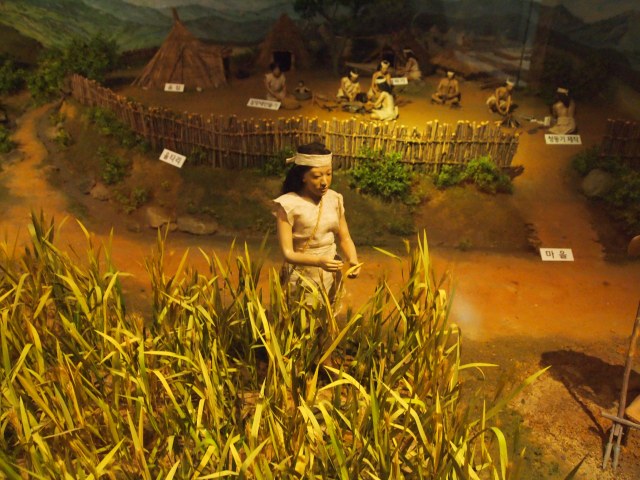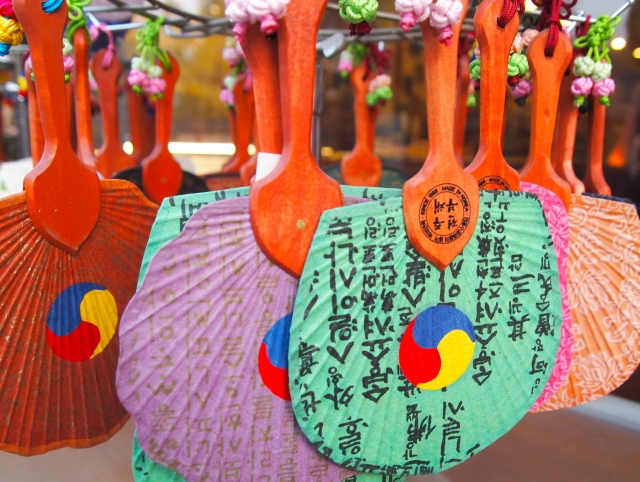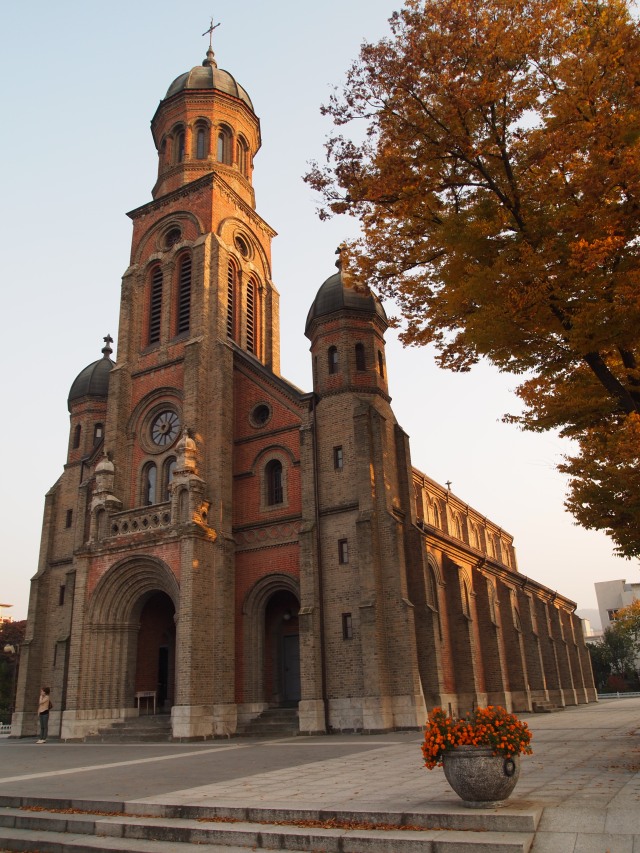November 5: It’s Friday morning and it seems there is to be no Hite Brewery for us. This despite the fact that we are the chosen ones, the “best EPIKers,” at least according to the name tags we are given. I have no idea what the criteria were that decided which Guest English Teachers (GETs) from Gyeongsangbuk-Do would get to attend this two-day field trip to Jeollabuk-do province, but somehow, we are special. Due to our specialness, our first planned stop at 11:30 a.m. is to be the Hite Brewery, where all of us are dreaming of sampling brews before heading off on the rest of our field trip. However, as we pull up to the brewery, we are told that on Fridays, Hite does not allow tourists to enter. Hmmm…. Strange thing, this, as wouldn’t you think our fearless planners would have checked this out in advance and confirmed our arrival with the brewery? Oh well, no beer to boost us off on our first day. It seems it will be a dry day.
Instead we bus onward to the exciting Jeonju National Museum. On our way, we make a stop at a rest area where we see this group of schoolchildren.
At the Jeonju National Museum, we see treasures we could never have imagined glimpsing in our lifetimes. Opened in 1990, this museum houses Jeollabuk-do’s cultural heritages; its collection encompasses 24,000 works including archeological and artistic relics from the prehistoric and Mahan and Baekje periods, as well as folklore materials. Nearly 1,400 works are displayed in 5 exhibition rooms and an outdoor exhibition area. The museum also houses Buddhist arts, ceramics, and metal crafts.
I am bowled over by three huge ceramic beautiful woven vases, swirling with jade, lapis blue, and deep Indian red & gold strands. I don’t know what these are, but they are stunning.
I see scrolls and paintings of interesting characters from the Joseon royal family, vases and pottery, bronze crowns and caps, dioramas of jumak taverns where tired travelers stopped for liquor, food and sleeping. A Jangdokdae jar stand depicts how Koreans keep their spices on a low stone embankment on a sunny side of the house. Basic seasonings are kept for all cooking done in the household, including soy sauce, soy bean and red pepper paste, red pepper powder, sesame, salt and kimchi.
After the museum, we head to a lunch of bibimbap. We eat bibimbap continually in Korea, but apparently Jeonju is especially known for two dishes: bibimbap and gongnamul gukbap (which I won’t discuss because we didn’t eat it!). Bibimbap is a mixture of a half-dozen seasoned vegetables, strips of marinated beef, sesame seed, seaweed, a fried egg, and a dollop of red pepper paste over a bowl of steamed rice. Often served in a brass container, the ingredients are to be mixed before eaten. As bibimbap is one of my favorite dishes in Korea, I enjoy it, and do even take note that it is better in Jeonju than in other places where I’ve eaten it.
After lunch we head to Hanok Maeul, a village of traditional-style Korean houses with tile roofs, high walls, and narrow alleyways. Most of us EPIK teachers saw this village during our orientation in February, 2010, so we’re a little baffled as to why we’ve come here again. We don’t complain too much as it is quite quaint and lovely. Possibly our planners may have thought, because we were a little disoriented during our orientation, that we might not remember we had come here before!
To start we go to a hilltop pavilion where we hear a woman perform traditional Korean music called pansori. It is vocal and percussion music performed by one singer and one drummer playing a barrel drum. From the hilltop, we have a great view of the tiled roofs of the village below.
This village is said to be the largest concentration of such traditional housing in the entire country. In recent years, many homes have been spiffed up and turned into accommodations, restaurants, gift shops, coffee shops or tea houses. The town is quite cheery at this time of year with its bright yellow ginkgo trees and other red-and-orange speckled trees.
Several guys in our group dress up in traditional costumes and pound rice with wooden mallets in a stone bowl to make rice cakes. It’s pretty funny as they really get into their roles and eat up the attention. We all get to sample the rice cakes after.
At the far end of the town, we explore the plush interior of the Jeondong Cathedral, a European-looking Catholic Church. On the grounds is a grotto guarded by a gleaming statue of the Virgin Mary; inside are candles that can be lit for prayers.
For dinner, we are supposed to have samgyeopsal, grilled three-layered (meat-fat-meat) thinly sliced pork loin, but instead, we have some kind of soup with unknown meat (possibly beef?) in it. We sit on floor mats at long low tables and drink Cokes and soju and eat the soup and other roots and vegetables and pancakes that usually accompany Korean meals.
As part of the purpose of this field trip is to meet and mingle with other EPIK teachers and forge new friendships, I sit somewhere randomly hoping to meet some new folks. I happen to sit next to a nice Korean-American young man named David. He surprises me by asking a fairly intense and thoughtful question, not the usually superficial banter that goes on at these gatherings. He asks, what is your biggest challenge here in Korea? I answer straightaway: loneliness. Being older than most of the EPIK teachers, I find I have little common ground with other teachers. And I don’t speak Korean to be able to make Korean friends. I ask him in return, What about you? He says he came here to discover his heritage, as both of his parents are Korean. Though brought up in California, he feels as Korean as a person can be. But, he describes that Koreans have a circle of who’s accepted. On the outside are the foreigners, who will never be inside of the circle. But on the fringes of the inside are people like David, Koreans but not Koreans. Both his parents are Korean; he was brought up Korean, but he’s American. He will never be a part of the inner circle. He is looked down upon because his first language is not Korean and thus not perfect; he seems uneducated to native Koreans. This despite the fact that he speaks several languages.
After we check in to our hotel, a number of people congregate in our room to play a rousing dice game called Farkle. We have a lot of fun; it’s great to meet some new people I’ve never met before. I also happen to win the game, which is always a happy event!






























You must be logged in to post a comment.